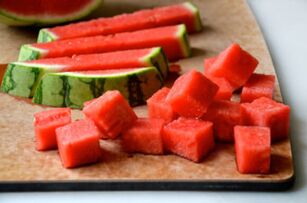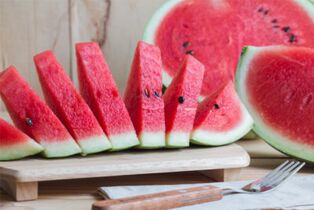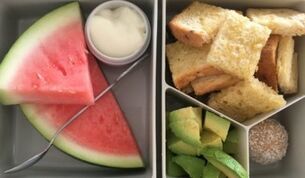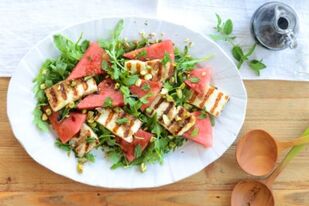There are probably few people who don't like the juicy sweet berry - watermelon. More than 90 percent of it consists of juice, the benefits of which are indicated for urolithiasis, since there are practically no acids, salts in the juice, but a large amount of alkali. There is also a fairly large amount of magnesium in the composition of watermelon, it is enough to eat a piece of watermelon to get the daily rate of phosphorus, iron, potassium, calcium.
Contains easily digestible sugars, microelements, vitamins of group B, C, PP. This berry will help with diseases of the cardiovascular system, hypertension, high cholesterol. If you take antibiotics for a long time, the juicy pulp will help remove drug residues from the body.

But the most important thing we want to talk about is that watermelon is a great help in losing weight, as there are only 30-40 kcal per hundred grams of pulp, but at the same time there is afeeling of satiety, and the presence of folic acid improves fat metabolism, helps the work of the circulatory and immune systems.
Success in weight loss is achieved due to the diuretic effect of this berry, while toxins, toxins and other harmful substances accumulated by the body are actively removed. The diuretic properties of watermelon are milder than drugs. A very important element in the composition of watermelon pulp is carotenoid lycopene, which has anticancer properties, helps slow down aging, thins and purifies the blood.
Test a watermelon for nitrates. Contraindications
Of course, a watermelon-based diet can only be offered in late summer, when the watermelons are ripe without additional growth accelerators and chemicals being applied. Nowadays, watermelon can be bought in the store at any time of the year, but we don't recommend it. In general, it is better to take the fruits grown in your garden (if you reside in the southern regions of the country), they may not be so sweet, rich in color, but you will be completely sure of their quality.
You can control the amount of nitrates in a watermelon in the following way: put a piece of pulp in a glass of water, if it contains nitrates, the pulp will soften in the glass, it will acquire a pasty state, without nitrates, the pieceit will practically keep its shape. By eating watermelons during their ripening period, you will receive both benefits and pleasure, because the juice of this fruit will perfectly quench your thirst and cleanse your body not only by urinating, but also by sweating, purifying the skin, pores, replenishing the body with microelements.

The watermelon diet is easily tolerated. During the period of the diet, you will only have to eat this berry, but at the same time in large quantities and at any time, it is possible at night (you just need to take into account that you will often have to get up to the toilet) and you will not feel hungry. At the same time, it is not necessary to painfully calculate the calories consumed, it is enough to know that one kilogram of pulp goes to ten kilograms of your body weight.
It is recommended to divide the consumption of watermelon into 5-6 doses, every three hours. This technique is ideal for the benefit of the body. By applying the watermelon diet, you will get results pretty quickly. If you're still having a hard time limiting your diet to just watermelon, you can add a small amount of rye and bran bread to your diet. But in this case, the diet will need to be extended.
Contraindications to the watermelon diet concern people who suffer from impaired kidney function and the genitourinary system (pyelonephritis, kidney stones) and diabetes mellitus.
Watermelon Diet: Menus and Results
When you use the watermelon diet, you can get rid of 3-5 kg in one week, and in 14 days you can lose up to 7-8 kg. But you need to prepare for such a long and complex diet, enter it gradually and only if you are confident in your health!
The 14 day diet allows you to include a small amount of different foods in your diet, but care should be taken to ensure they are not very high in calories.
For breakfast, you can add a boiled chicken egg or 100 grams of low-fat cottage cheese or a small amount of porridge in water. For lunch, eat a slice of lean beef or veal, or a slice of chicken or fish, all of this must be boiled or steamed, vegetables. Dinner should only consist of watermelon pulp.
Watermelon diets can be combined with other foods. We offer several diet options with different menus:
Melon-based diet
First option:
- breakfast - toast, low fat cottage cheese 60-80 gr. , 200 grams of melon;
- lunch - up to 150 grams of boiled fish, lettuce and melon, 150 grams of cheese;
- afternoon tea - 400-500 grams of watermelon pulp;
- dinner - a portion of boiled rice (150-200 grams), carrots + apples 100 grams, a piece of melon.
Second option:
- breakfast - a boiled egg, 150-200 grams of watermelon pulp;
- lunch - stewed vegetable stew 100-150 grams, 350-400 grams of melon;
- afternoon snack - low-fat cottage cheese 150-200 grams;
- dinner - 100-150 grams of boiled chicken or turkey, toast and 400-500 grams of watermelon pulp.
Third option:
- breakfast - natural yogurt 150 grams, 400-500 grams of watermelon watermelon diet watermelon diet;
- lunch: steamed turkey or chicken fillets 100-150 grams, rice 150 grams, melon 400-450 grams;
- afternoon snack: a piece of bran bread or crusty bread
- dinner - vegetable salad 150-200 grams, a boiled potato, 400-500 grams of watermelon watermelon diet watermelon diet.
Fourth option:
- breakfast - rye toast + cheese, 200-300 grams of watermelon or oatmeal with melon;
- lunch - boiled chicken breast with buckwheat porridge and fresh vegetable salad, or vegetable soup without potatoes and 100-150 grams of boiled (or steamed) lean meat, or steamed turkey cutlets 100 grams, 150 grams of rice and green beans;
- Afternoon snack 300-400 grams of watermelon;
- dinner: 100-120 grams of low-fat cottage cheese and 200-300 grams of melon.
If you are on a melon diet, do not drink immediately after meals. You can drink green tea or a glass of water in one hour. The menu must be alternated.

Diets with watermelon, kefir, protein and bread
- The watermelon-kefir diet includes two products, 0 or 1% fat kefir and watermelon. It is necessary to take turns eating a glass of kefir or 300-400 grams of watermelon pulp every three hours. It is best to start the day with the pulp of a watermelon and end with kefir.
- The watermelon protein diet involves the consumption of watermelon between main meals - 400-500 grams for 10-14 days. The main food items these days should be: boiled chicken or turkey fillets, steamed fish of non-fat varieties, eggs, low-fat cottage cheese and cheese and low-fat kefir, seafood, vegetables.
- A watermelon and black bread diet involves the consumption of 0. 5 loaves of black bread (better stale) and watermelon pulp per day, as mentioned above, at the rate of one kilogram of pulp per 10 kilograms of weightbodily. If you wish and if you can, reduce the consumption of bread to 100 grams or replace it with two spoons. spoons of oat bran and you can add a salad of thinly sliced white cabbage, carrots and beets, a few drops of lemon juice and olive oil.
If at the end of the diet you get out of it correctly (the main rule is graduality), the lost kilograms will not return to you, in any case, not as quickly as you lost them. To do this, observe the following rules within two weeks of the watermelon diet: 1) do not skip breakfast, 2) your diet should include foods rich in protein and carbohydrates, 3) it is important not to slow down your metabolism.
The main foods after a two week diet should be:
- porridge;
- lean fish boiled or steamed;
- boiled lean meat (chicken, turkey);
- fermented milk products (low-fat cottage cheese and kefir, natural yogurt);
- vegetables;
- fruits;
- eggs.

And 2-3 hours before bedtime, continue to eat one kilogram of watermelon for 30 kilograms of body weight.
Fasting days on watermelons can be arranged 2-3 times a week, by eating two kilograms of watermelon pulp. It is very important: engage in physical activity to the best of your abilities, at least at home, without a coach and gym, or in the form of walking.














































